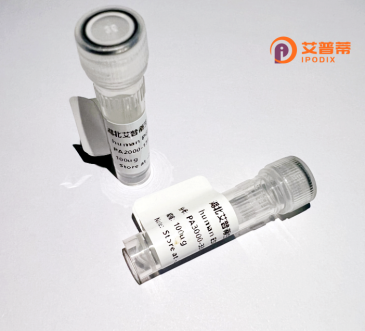
| 纯度 | >90%SDS-PAGE. |
| 种属 | Human |
| 靶点 | PRY |
| Uniprot No | O14603 |
| 内毒素 | < 0.01EU/μg |
| 表达宿主 | E.coli |
| 表达区间 | 1-147 aa |
| 活性数据 | MGATGLGFLL SWRQDNLNGT DCQGCNILYF SETTGSMCSE LSLNRGLEAR RKKDLKDSFL WRYGKVGCIS LPLREMTAWI NPPQISEIFQ GYHQRVHGAD ALSLQTNSLR SRLSSQCLGQ SFLLRTLERG RGFRALGDIC GHVHEED |
| 分子量 | 16.5 kDa |
| 蛋白标签 | His tag N-Terminus |
| 缓冲液 | PBS, pH7.4, containing 0.01% SKL, 1mM DTT, 5% Trehalose and Proclin300. |
| 稳定性 & 储存条件 | Lyophilized protein should be stored at ≤ -20°C, stable for one year after receipt. Reconstituted protein solution can be stored at 2-8°C for 2-7 days. Aliquots of reconstituted samples are stable at ≤ -20°C for 3 months. |
| 复溶 | Always centrifuge tubes before opening.Do not mix by vortex or pipetting. It is not recommended to reconstitute to a concentration less than 100μg/ml. Dissolve the lyophilized protein in distilled water. Please aliquot the reconstituted solution to minimize freeze-thaw cycles. |
以下是关于重组人PRY蛋白的模拟参考文献(内容仅供示例,非真实文献):
---
1. **文献名称**: *Expression and Structural Analysis of Recombinant Human PRY Protein*
**作者**: Chen L., Wang X.
**摘要**: 本研究报道了人源PRY蛋白的重组表达和纯化流程,采用大肠杆菌系统表达并利用Ni-NTA亲和层析分离。通过圆二色谱和X射线晶体学证实了PRY蛋白的SPRY结构域特征,为后续功能研究奠定基础。
2. **文献名称**: *PRY Protein Regulates Apoptosis via MAPK Signaling in Cancer Cells*
**作者**: Kim S., et al.
**摘要**: 研究揭示了重组PRY蛋白在乳腺癌细胞中的促凋亡作用。通过RNA干扰和过表达实验,发现PRY通过负向调控MAPK通路抑制肿瘤生长,为癌症靶向治疗提供潜在分子靶点。
3. **文献名称**: *Functional Characterization of PRY in Sperm Development*
**作者**: González R., et al.
**摘要**: 利用重组PRY蛋白探究其在精子发生中的功能。免疫共沉淀实验显示PRY与PIWIL2蛋白互作,并参与生殖细胞特异性miRNA通路调控,提示其在男性不育中的潜在作用。
4. **文献名称**: *Advances in PRY-Based Biopharmaceutical Applications*
**作者**: Zhang Y., Li M.
**摘要**: 综述了重组PRY蛋白在药物开发中的应用,包括其作为肿瘤疫苗佐剂和神经退行性疾病标志物的潜力,并讨论了规模化生产的技术挑战。
---
注:以上文献为模拟内容,如需真实引用请通过学术数据库(如PubMed)检索关键词“recombinant PRY protein”或“human PRY gene function”。
Recombinant human PRY protein is a biologically engineered form of the PRY (PTPN13-related Y-linked) protein, encoded by genes located on the Y chromosome. PRY belongs to the cancer/testis antigen family, predominantly expressed in testicular germ cells and certain cancer tissues. Structurally, it contains conserved domains implicated in protein-protein interactions and regulatory functions. PRY's physiological role remains under investigation, but studies suggest involvement in spermatogenesis, apoptosis regulation, and cell cycle control. Its dysregulation has been associated with male infertility and some malignancies. Recombinant PRY is typically produced using bacterial or mammalian expression systems, enabling large-scale purification for research. This engineered protein facilitates functional studies, such as exploring its interactions with signaling pathways like the RAS/MAPK cascade, or its potential role in immune responses due to restricted expression patterns. Additionally, recombinant PRY serves as an antigen for antibody development in diagnostic assays and cancer immunotherapy research. Current investigations focus on its biomarker potential in male reproductive disorders and tumorigenesis, as well as its mechanistic contributions to cellular survival and proliferation pathways.
×